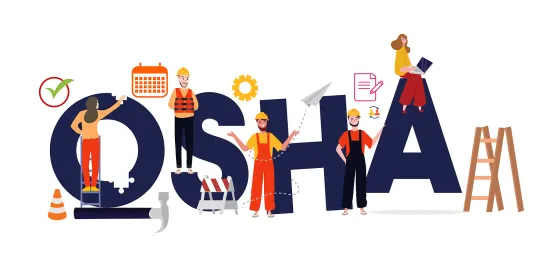This is the ninth installment in a series of articles intended to provide the reader with a very high-level overview of the Occupational Safety and Health (OSH) Act of 1970 and the Occupational Safety and Health Administration (OSHA) and how both influence workplaces in the United States.
By the time this series is complete, the reader should be conversant in the subjects covered and have developed a deeper understanding of how the OSH Act and OSHA work. The series is not—nor can it be, of course—a comprehensive study of the OSH Act or OSHA capable of equipping the reader to address every issue that might arise.
The first article in this series provided a general overview of the OSH Act and OSHA; the second article examined OSHA’s rulemaking process; the third article reviewed an employer’s duty to comply with standards; the fourth article discussed the general duty clause; the fifth article addressed OSHA’s recordkeeping requirements; the sixth article covered employees’ and employers’ respective rights; the seventh article addressed whistleblower issues; and the eighth article covered the intersection of employment law and safety issues. In this, the ninth article in the series, we examine OSHA’s Hazard Communication Standard (HCS).
Quick Hits
- OSHA’s Hazard Communication Standard (HCS) was established in 1982 to ensure that employees who are exposed—or are reasonably likely to be exposed—to chemicals in the workplace are aware of the hazards and know how to protect themselves effectively.
- The HCS mandates that all employers use a hazard communication program to inform employees about the hazardous chemicals to which employees may be exposed.
- The standard has been amended several times since 1982, most recently with a final rule issued in May 2024 to align with international standards.
In 1982, OSHA established its HCS based on a purpose best described by a single word: awareness. The HCS was intended to promote workplace health and safety by ensuring that employees who were exposed or reasonably likely to be exposed to chemicals in the workplace had knowledge of the hazards, and, accordingly, the know-how to protect themselves effectively.
The first HCS standard required chemical manufacturers and importers only to evaluate hazards and ensure that this information was communicated to the wholesale consumers and end users of hazardous chemicals—the employers and employees. Over the years, OSHA has amended its HCS several times, expanding its scope and attempting to keep up with international standards. In fact, in May 2024, OSHA issued a final rule updating the HCS to align with the seventh revision of the United Nations’ Globally Harmonized System of Classification and Labelling of Chemicals. The new rule took effect on July 19, 2024.
Purpose and Scope of the Hazard Communication Standard
According to OSHA, the purpose of the HCS is to ensure that the hazards of all chemicals produced or imported are classified and that information concerning the classified hazards is transmitted to employers and employees. To that end, in addition to placing extensive labeling and other requirements on manufacturers and importers of hazardous chemicals, the HCS mandates that “all employers … provide information to their employees about the hazardous chemicals to which they are exposed, by means of a hazard communication program, labels and other forms of warning, safety data sheets, and information and training.”
HAZCOM Program Requirement
The HCS mandates that all employers whose employees are or may be exposed to hazardous chemicals develop, implement, and maintain at each workplace a written hazard communication (HAZCOM) program. The written program must describe how the employer will comply with the HCS’s requirements related to labeling hazardous chemicals, maintenance of safety data sheets, and employee information and training. Additionally, the written program must contain a list of the hazardous chemicals known to be present in the workplace and the method the employer will use to inform employees of hazards associated with nonroutine tasks.
For multiemployer worksites, an employer’s HAZCOM program must also set forth the method the employer will use to provide other employers on-site access to safety data sheets, the method the employer will use to inform other employers of precautionary measures necessary to protect employees in normal operation conditions as well as in foreseeable emergencies, and how the employer will inform other employers about the worksite’s labeling system.
Labels and Other Warnings
Labels are a critical component of the HCS in ensuring that employers and employees are aware of the presence of hazardous chemicals in the workplace. Usually, labels are the first tool to alert employees to the presence of hazardous chemicals. OSHA has aptly described the role of a label as that of a “snapshot” intended to serve as the initial reminder to workers that materials may be hazardous. Chemical manufacturers and importers must provide detailed labels that include product and supplier identifiers, as well as “signal word[s],” “pictogram[s],” and “hazard statement[s]” for each class, in addition to “precautionary statement[s].”
Employers are also responsible for labels for hazardous chemicals once they arrive at the workplace. Employers must ensure that each container of hazardous chemicals is labeled, tagged, or marked with a product identifier and words, pictures, symbols, or combination thereof. Labels must provide, at a minimum, general information regarding the chemical hazards that will provide employees with specific information regarding the physical and health hazards of the hazardous chemical. Employers cannot “remove or deface existing labels on incoming containers of hazardous chemicals” that they receive, unless they “immediately mark[]” the container with another appropriate label. The labels or other types of warnings must be legible and written in English. Employers with employees who speak other languages may add the information in their languages to the material presented, as long as the information is presented in English as well.
Safety Data Sheets
Labels are intended to serve as the initial reminder to employers and employees of the presence of hazardous chemicals. Safety data sheets (SDSs) are designed to provide more substantive means of ensuring awareness of hazardous chemicals in the workplace. To that end, chemical manufacturers, importers, and employers must develop and maintain SDSs for hazardous chemicals. SDSs must follow a specified format and include:
- identification, including identification of hazards;
- composition/information on ingredients;
- measures to take, including first aid, fire-fighting procedures, and accidental release protocols;
- handling and storage, including exposure controls and personal protection;
- physical and chemical properties of the substance, as well as its “stability and reactivity”;
- toxicological and ecological information, and considerations regarding each chemical’s disposal;
- transport information;
- regulatory information; and
- “[o]ther information, including date of preparation or last revision.”
Each SDS must be written in English, although duplication in other languages is permissible. Manufacturers, importers, distributors, and employers each have a continuing obligation to provide accurate information on SDSs. Employers and distributors must revise SDSs for chemicals within three months of becoming aware of any new, significant information regarding the hazards of chemicals.
Information and Training
The final key component of the HCS is information and training. The purpose of this requirement is to ensure employee awareness by providing information directly to employees as well as training. Employers must provide employees with “effective information and training” regarding hazardous chemicals in the workplace at the time of their initial assignment and whenever a chemical hazard employees have not previously been trained about is introduced to their work area. The information provided to employees must include:
- the requirements of the HCS;
- “[a]ny operations in their work area where hazardous chemicals are present”; and
- “[t]he location and availability of employer’s written hazard communication program” (including the required list of hazardous chemicals and SDSs).
The training provided to employees must include:
- “methods and observations that may be used to detect the presence or release of a hazardous chemical in the work area”;
- “the physical, health, simple asphyxiation, combustible dust, and pyrophoric gas hazards, as well as hazards not otherwise classified, of the chemicals in the work area”;
- “the measures employees can take to protect themselves from these hazards, including specific procedures the employer has implemented to protect employees from exposure to hazardous chemicals, such as appropriate work practices, emergency procedures, and personal protective equipment to be used”; and
- “the details of the hazard communication program developed by the employer, including an explanation of the labels received on shipped containers and the workplace labeling system used by their employer; the safety data sheet, including the order of information and how employees can obtain and use the appropriate hazard information.”





 />i
/>i

